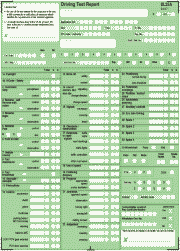This is a VERY old article and should not be taken as guidance now.
UPDATE: The DSA has now embarked on its implementation of coaching, so read this article posted in November 2012.
 The marking sheet they use for your driving test is called a DL25. When you take your test, pass or fail you will get a copy of it and an attached sheet which explains what is/was expected of you under all the headings. I wrote about this a little while ago. See this topic to download a copy.
The marking sheet they use for your driving test is called a DL25. When you take your test, pass or fail you will get a copy of it and an attached sheet which explains what is/was expected of you under all the headings. I wrote about this a little while ago. See this topic to download a copy.
On one of the forums, someone who goes through the DL25 with their pupils at some point prior to their test has asked if this might be seen as just teaching people to pass the test, instead of teaching them to drive.
I suspect that what he meant was that he goes through the DL25 including the explanations sheet that comes with it. Even if he doesn’t, if he explains exactly what is involved under each section then it amounts to the same thing.
The simple and obvious answer is that if you explain what the examiner is looking for in all those possible cases, and especially when something that the examiner wouldn’t be happy with occurs on a lesson, then you are not just teaching them to pass the test. You are giving them a complete picture of what is acceptable and what isn’t.
A prime example is the turn in the road (TIR), or three-point turn as some people still call it. At some stage the pupil will bump the kerb or not look around enough. Certainly if they touch the kerb, most of them will say “you fail if you touch the kerb, don’t you?” This is where the DL25 comes in and provides an ideal teaching opportunity.
I get them to read the part about the TIR, and show them how they are being marked for control and observation/safety:
Turn in the road
Keep a look out for traffic and pedestrians whenever you are turning your vehicle and be prepared to give way to them. Control your vehicle smoothly. Do not let the vehicle mount the pavement. Try not to touch the kerbs as this could damage your vehicle and endanger other road users and pedestrians.
Then the conversation goes something like this:
Me: See that part about mounting the kerb? Is that the same as just touching it?
Them: No.
Me: So what do you think the examiner would do if you just touched it gently as you were stopping?
Them: Well, if I don’t go on the pavement… it says TRY not to touch the kerb.
Me: Exactly! But what if you didn’t even try and stop and bumped the pavement hard?
Them: That’s different, though.
Me: Yes, it is. Because if you’re trying to stop you obviously know where the kerb is. But if you don’t, what does that say about your control?
Them: It’s bad.
Me: Yes. So you can see how the examiner might not look at it the same way you do.
And what about taking more than three moves to get it round? It isn’t called a “three point turn”, so you can take as many tries as you want in theory. But what if you could get it round in three but end up taking five or seven moves? Are you in control?
Them: Ummm. Well, no.
Me: Arguably, no, I agree. So it’s best to get it absolutely right. But it doesn’t say you MUST do it in three goes, and you can never be sure how the examiner sees it. If the rest of your drive is good then it might be viewed differently. One thing you must never do is assess yourself as you’re going along and assume you have failed. Focus on what is coming up and drive the way you can normally drive.
And what about your observations – that’s where they mark under “safely” – what does it say about those?
Them: Just that I’ve got to look for other people.
Me: And…?
Them: Oh, and give way to them.
Me: What does “give way” mean?
And so it continues as necessary, depending on the situation. You can use the DL25 to turn a potentially bland lesson into a turbo-charged one, complete with a bit of “coaching” (hack, spit). The whole thing only takes a few minutes, it dispels any myths they’ve heard, and it makes them think and work the answers out for themselves. It brings them out of their shells, and gets them involved.
We also shouldn’t forget that – like it or not – there IS an element of having to do things in a certain way in order to pass the test, even if under normal circumstances there wouldn’t be a problem with doing them slightly differently.
People who steer clear of the DL25 are missing a trick or two – but I’m sure they’re still Grade 1 Lifeskills Coaches in their own living rooms.